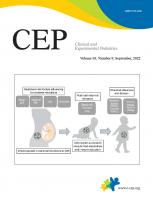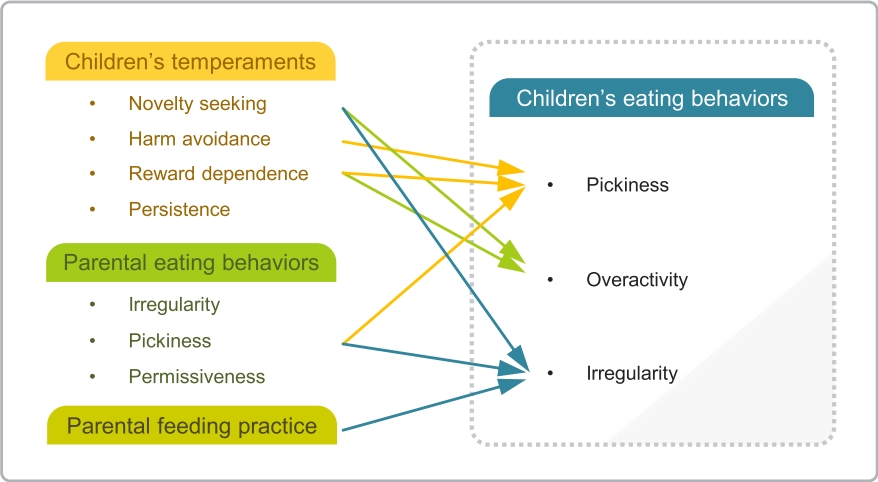Article Contents
| Clin Exp Pediatr > Volume 65(9); 2022 |
|
Graphical abstract
To the Editor
Young childrenвҖҷs eating behavior is very important for kids to form a healthy eating habit throughout their life and to prevent a disease related to a diet. Preschool children who show a desirable eating behavior have few cases of revealing obesity, hypertension, diabetes, hyperlipidemia and an eating disorder when reaching adulthood. Accordingly, what children are allowed to have a desirable eating habit is very crucial for establishing the nationвҖҷs health policy and reducing its cost. However, there are many children unfortunately who do not have a desirable eating habit. To make therapeutic intervention in order for these young kids to be capable of having a good habit in the period of infants and toddlers that the early habit is formed, it may be considered to be significant to examine which influential factors there are upon infantsвҖҷ eating behaviors and to look into what the most influential factor is.
A questionnaire survey was conducted targeting healthy children aged 36вҖ“72 months who visited a pediatric clinic, and their parents. Totally 166 children participated in the survey. Examining the distribution of the collected data, the ratio of gender amounted to 80 little boys (48.2%) and 86 little girls (51.8%). The proportion of ages came to 32 people at age 3 (19.3%), 58 people at age 4 (34.9%), 76 people at age 5 (45.8%). This study was progressed by receiving the approval of Institutional Review Board (approval number: HYUIRB-202105-007-1).
To see infantsвҖҷ problematic eating-behavior scale, the child-domain questionnaire in the eating behavior test for infant and young children [1] was used. The child eating-behavior domain includes three factors in pickiness, overactivity, irregularity. To look for parental eating behaviors, the parent-domain questionnaire in the eating behavior test for infant and young children [1] was used. The parent eating-behavior domain includes 3 factors of irregularity, pickiness, permissiveness. And to see parental feeding styles, the questionnaire in the parent domain for the eating behavior test for infant and young children [1] was used. InfantsвҖҷ temperaments were evaluated by using the Junior Temperament and Character Inventory [2]. InfantsвҖҷ temperament domain includes 4 factors in novelty seeking, harm avoidance, reward dependence, and persistence.
Statistical processing was applied IBM SPSS Statistics ver. 22.0 (IBM Co., Armonk, NY, USA). A relationship among the child age, the parental eating behaviors, the parentsвҖҷ feeding practices, the childrenвҖҷs temperaments, and the childrenвҖҷs eating behaviors was analyzed by using Pearson correlation analysis. To figure out the influence upon problematic eating behaviors in the factors of showing a correlation with childrenвҖҷs problematic eating behaviors, the multiple regression analysis was carried out by using the Forward Selection Method.
The pickiness among childrenвҖҷs eating behaviors presented a positive correlation with parentsвҖҷ picky eating behavior, parentsвҖҷ permissive dietary behavior, childrenвҖҷs novelty-seeking temperament, harm-avoidance temperament, and reward dependence. Next, overactivity among childrenвҖҷs eating behaviors reflected a positive correlation with parentsвҖҷ permissive eating behavior, childrenвҖҷs novelty-seeking temperament, and childrenвҖҷs reward dependence. And it indicated a negative correlation with childrenвҖҷs persistence. Lastly, irregularity among childrenвҖҷs eating behaviors expressed a positive correlation with pickiness among parental eating behaviors and novelty seeking among childrenвҖҷs temperaments. It showed a negative correlation with parentsвҖҷ feeding practice and persistence among childrenвҖҷs temperaments.
The pickiness among infantsвҖҷ problematic eating behaviors could be known to be affected by harm avoidance (ОІ=0.258), reward dependence (ОІ=0.196) out of young childrenвҖҷs temperaments and parentsвҖҷ picky dietary life (ОІ=0.154). The overactivity out of young childrenвҖҷs problematic eating behaviors appeared to be influenced by novelty seeking (ОІ=0.275) and reward dependence (ОІ=0.191). Among infantsвҖҷ problematic eating behaviors, the irregularity was indicated to be affected by parentsвҖҷ picky dietary life (ОІ=0.237) parentsвҖҷ feeding practice (ОІ=-0.261) and childrenвҖҷs novelty seeking temperament (ОІ=0.148) (Table 1).
A child with high harm-avoidance propensity may express strong resistance while the child feels that a stimulus to new food is dangerous. Children with high reward dependence can be sensitive to irritation around them, they also can respond to new food stimulation sensitively. In case of picky eating behaviors of parents, the parents themselves can be seen to be serious in picky eating or to be strong in aversion to new food. The parents' picky senses might be inherited by their children [3], and even by which the parentsвҖҷ eating behaviors were modeled on their children, resulting in having been learnt in living [4].
Children with high novelty-seeking temperament get excited easily by new stimuli and may represent a difficulty in observing the rule of eating during mealtime. Children with high reward dependence reflect the problem of overactive eating habit. In accordance with the research, the eating disorders (anorexia nervosa, bulimia nervosa) may develop into reward-dependent syndromes. The abnormal behavior and the abnormal reward process in patients with eating disorders have influence upon energy balance and hormones (leptin, ghrelin). And so the patients with eating disorders can present hyperactivity which is potentially rewarding for eating disorder patients [5]. Moreover, the adult attention-deficit hyperactivity disorder children who show hyperactivity are sensitive to rewards, but the pattern of reinforcement may be different from that of normal children [6].
For the last, the irregularity in eating behavior is the scale that shows whether being constant in the amount of food, whether looking for food at regular times, and whether being the same in an eating pattern. Children who have higher novelty-seeking temperament are more impulsive and have difficulties in accepting the rules and keeping regular eating habits. And вҖҳpickinessвҖҷ among parental eating-behavior problems implies parentsвҖҷ serious picky eating or repulsion against strong scent or new food. Children have a high tendency to model the eating behavior of a person who has a close relationship. Thus, the parental eating behavior may have an effect on children [7]. ParentsвҖҷ appropriate feeding practice is what shows how much the parents are involved in and control their children's meals. Thus, the lower the parentsвҖҷ feeding practices may lead to showing the irregular eating behaviors. Children who were nurtured with parentsвҖҷ well-structured parenting style can be known to have a more regular eating habit [8].
According to other research, the eating behavior was represented depending on age [9]. But this study could not evaluate the difference in eating behaviors depending on the age because of the narrow range of age. Furthermore, parentsвҖҷ behavior and child-rearing attitude may affect on the formation of childrenвҖҷs temperament [10]. Consequently, a more in-depth further research is needed between childrenвҖҷs temperament and parentsвҖҷ behavior and child-rearing attitude.
TableВ 1.
Stepwise multiple regression analysis on the factors of influencing childrenвҖҷs picky eating behaviors, overactive eating behavior, and irregular eating behaviors
| Variable | ОІ | F | R2 | Adjusted R2 |
|---|---|---|---|---|
| Picky eating behaviors | 10.539*** | 0.163 | 0.148 | |
| вҖғChildrenвҖҷs temperament | ||||
| вҖғвҖғHarm avoidance | 0.258** | |||
| вҖғвҖғReward dependence | 0.196** | |||
| вҖғвҖғNovelty seeking | 0.082 | |||
| вҖғParental eating behavior | ||||
| вҖғвҖғPickiness | 0.154* | |||
| вҖғвҖғPermissiveness | 0.041 | |||
| Overactive eating behavior | 11.221*** | 0.121 | 0.11 | |
| вҖғChildrenвҖҷs temperament | ||||
| вҖғвҖғNovelty seeking | 0.275*** | |||
| вҖғвҖғReward dependence | 0.191** | g | ||
| вҖғвҖғPersistence | -0.175 | |||
| вҖғParental eating behavior | ||||
| вҖғвҖғPermissiveness | 0.116 | |||
| Irregular eating behavior | 12.569*** | 0.189 | 0.174 | |
| вҖғChildrenвҖҷs temperament | ||||
| вҖғвҖғNovelty seeking | 0.148* | |||
| вҖғвҖғPersistence | 0.063 | |||
| вҖғParental eating behavior | ||||
| вҖғвҖғPickiness | 0.237** | |||
| вҖғParentsвҖҷ feeding practice | ||||
| вҖғвҖғParentsвҖҷ feeding style | -0.261*** |
A relationship among the child age, the parental eating behaviors, the parentsвҖҷ feeding practices, the infantsвҖҷ temperaments, the young childrenвҖҷs eating behaviors was parsed with Pearson simple correlation analysis. After then, to look into the influence upon problematic eating behaviors in factors of reflecting a correlation with childrenвҖҷs problematic eating behaviors, the multiple regression analysis was executed by using the Forward Selection Method.
References
1. Han Y, kim SA, Lee Y, Kim J. The development and validation of eating behavior test form for infants and young children. Korean J Community Nutr 2015;20:1вҖ“10.

2. Lyoo IK, Han CH, Lee SJ, Yune SK, Ha JH, Chung SJ, et al. The reliability and validity of the junior temperament and character inventory. Compr Psychiatry 2004;45:121вҖ“8.


3. Food fussiness--it may be inherited! Child Health Alert 2007;25:4.
4. Scaglioni S, Salvioni M, Galimberti C. Influence of parental attitudes in the development of children eating behaviour. Br J Nutr 2008;99 Suppl 1:S22вҖ“5.


5. Monteleone AM, Castellini G, Volpe U, Ricca V, Lelli L, Monteleone P, et al. Neuroendocrinology and brain imaging of reward in eating disorders: A possible key to the treatment of anorexia nervosa and bulimia nervosa. Prog Neuropsychopharmacol Biol Psychiatry 2018;80(Pt B): 132вҖ“42.


6. Furukawa E, Bado P, Tripp G, Mattos P, Wickens JR, Bramati IE, et al. Abnormal striatal BOLD responses to reward anticipation and reward delivery in ADHD. PLoS One 2014;9:e89129.



7. Cruwys T, Bevelander KE, Hermans RC. Social modeling of eating: a review of when and why social influence affects food intake and choice. Appetite 2015;86:3вҖ“18.


8. Lopez NV, Schembre S, Belcher BR, O'Connor S, Maher JP, Arbel R, et al. Parenting styles, food-related parenting practices, and children's healthy eating: a mediation analysis to examine relationships between parenting and child diet. Appetite 2018;128:205вҖ“13.









 PDF Links
PDF Links PubReader
PubReader ePub Link
ePub Link PubMed
PubMed Download Citation
Download Citation


